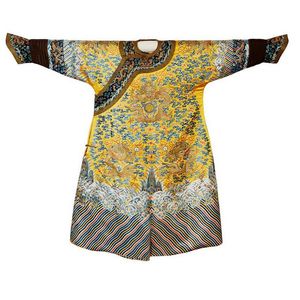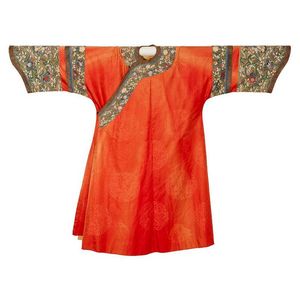Chinese Red Silk Kesi Ladies Robe with Dragon Roundels
You must be a subscriber, and be logged in to view price and dealer details.
Subscribe Now to view actual auction price for this item
When you subscribe, you have the option of setting the currency in which to display prices to $Au, $US, $NZ or Stg.
- Ming Dynasty - The Ming Dynasty was a ruling dynasty of China from 1368 to 1644. It succeeded the Yuan Dynasty and preceded the Qing Dynasty. The Ming Dynasty was established by Zhu Yuanzhang, a former Buddhist monk who became a rebel leader and eventually overthrew the Mongol Yuan Dynasty. During the Ming Dynasty, China experienced a period of relative stability and prosperity. The government was centralized and bureaucratic, with the emperor at the top of the hierarchy. The Ming Dynasty is known for its cultural achievements, including the development of porcelain, the invention of movable type printing, and the construction of the Great Wall of China.
- Roundel - A roundel is a circular disk, medallion or border on a plate or dish, on an object of furniture. A plate or dish will often have a central circular bordered decoration, termed a roundel. In furniture the word is often used instead of the word 'patera' to describe a turned circular decoration. In recent times use of the word has expanded to encompass any circular area on an object.
- Monochrome / Monochromatic - A painting or drawing finished in a single colour, or in different shades of a single color.
This item has been included into following indexes:
- Oriental textiles & costume, Chinese
Visually similar items

A Chinese twelve symbol Emperor's semi-formal court robe, Jifu, Qing Dynasty (1644-1911), circa 1850, This robe made for the Emperor, is beautifully decorated with the twelve symbols of Imperial authority, arranged discreetly among a number of other symbol

An impressive Chinese Imperial yellow dragon robe, (Longpao Jifu), Qing Dynasty (1644-1911), Daoguang period (c1820), This excellent and rare Manchu nine-dragon robe, has been embroidered with the finest silk and couched gold-wrapped thread on a rich satin

A fine quality Chinese 19th century summer robe in green gauze embroidered in coloured silks with flowers, bats, roundrels and mythical birds within floral borders. All over sea wave border.

An important Chinese Imperial Prince's robe, Qing Dynasty (1644-1911), circa 1800-1830, the black silk Autumn dragon robe with Imperial dragons couched in golden thread, with auspicious Buddhist and Daoist symbols, and medallion roundels of dragons on the
